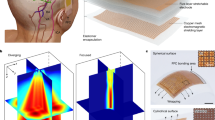Abstract
IT has been noted by Winton1 and has since been confirmed many times2–5, that the renal vascular resistance is not constant but increases with increasing arterial pressure in the range 80–120 mm. mercury mean pressure. The phenomenon does not depend on an intact nerve supply to the kidney but occurs in the denervated, perfused kidney. The autoregulation of renal blood flow has been considered attributable either to an active vasomotor process3–5 or, in some recent work, to a flow-dependent separation of plasma from red cells in the renal circulation. The first of these theories appears to have been developed only by the process of elimination, and the second appears no longer tenable in the light of experiments by several groups5–7. The œdematous kidney displays a high resistance to flow which probably results from compression of vessels by extravascular fluid. This factor has not been considered important in the function of kidneys subjected to normal arterial and venous pressure, since measurements of renal tissue pressure5 indicated that it does not vary directly with renal vascular resistance.
This is a preview of subscription content, access via your institution
Access options
Subscribe to this journal
Receive 51 print issues and online access
$199.00 per year
only $3.90 per issue
Buy this article
- Purchase on Springer Link
- Instant access to full article PDF
Prices may be subject to local taxes which are calculated during checkout
Similar content being viewed by others
References
Winton, F. R., Trans. Fourteenth Congresso Internaz. de Fisiol., 264 (1932).
Shipley, R. E., and Study, R. S., Amer. J. Physiol., 167, 676 (1951).
Ochwadt, B., Pfluger's Arch. ges. Physiol., 262, 207 (1956).
Pappenheimer, J. R., and Kinter, W. B., Amer. J. Physiol., 185, 377 (1956).
Thompson, D. D., Kavaler, F., Lozano, R., and Pitts, R. F., Amer. J. Physiol., 191, 493 (1957).
Miles, B. E., Ventom, M. G., and de Wardener, H. E., J. Physiol., 123, 143 (1954).
Waugh, W. H., Circ. Res., 6, 363 (1958).
Goodwin, R. S., and Sapirstein, L. A., Circ. Res., 5, 532 (1957).
Winton, F. R., Harvey Lecture, 47, 21 (1951–52).
Author information
Authors and Affiliations
Rights and permissions
About this article
Cite this article
SCHER, A. Mechanism of Autoregulation of Renal Blood Flow. Nature 184, 1322–1323 (1959). https://doi.org/10.1038/1841322a0
Issue Date:
DOI: https://doi.org/10.1038/1841322a0
This article is cited by
-
Zur Lokalisation der autoregulativen Widerstandsänderungen in der Niere
Pflüger's Archiv für die gesamte Physiologie des Menschen und der Tiere (1962)
-
�ber �nderungen von Gewicht und ven�sem H�matokrit der Niere als Ausdruck transvasaler Fl�ssigkeitsverschiebung
Pfl�gers Archiv f�r die Gesamte Physiologie des Menschen und der Tiere (1961)
Comments
By submitting a comment you agree to abide by our Terms and Community Guidelines. If you find something abusive or that does not comply with our terms or guidelines please flag it as inappropriate.



